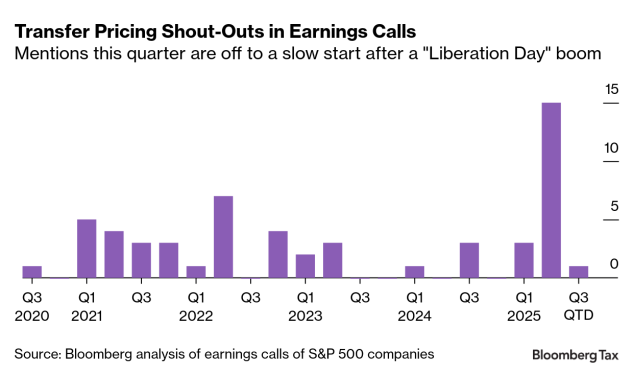Top executives are diving deep into the weeds on their companies’ transfer pricing decisions as tariffs supercharge the financial impact of intercompany transactions.
At stake could be billions of dollars possibly lost to audits from newly invigorated teams at tax departments and customs agencies on the lookout for tariff-evading maneuvers.
Transfer pricing practitioners hope the executive interest will stick around even when the tariff tumult is gone, as big-dollar tax audits become more common and tax authorities rack up wins in court—all while shareholders demand more transparency on the tax risks companies are taking.
“Before tariffs, C-suite involvement at most companies was generally limited to some high-level CFO oversight regarding tax reserves and documentation,” Steve Wrappe, Grant Thornton transfer pricing leader, said.
Not anymore.
“The entire C-suite needs to understand the company’s transfer pricing approach, and substantive and procedural strategy for defense,” he said.
President Donald Trump’s “Liberation Day” tariffs kicked off a scramble inside companies to make sense of the new realities. And one of the first areas of risk—and opportunity—is transfer pricing, the valuation of cross-border transactions between units of a company.
Transfer pricing is intimately linked with customs, because how a company prices its intercompany transactions for tax reasons has a huge influence on the customs price. Changing that price through a transfer pricing adjustment can reduce the tariff owed—if done properly. Additionally, nearly half of US trade is between related companies.
That also means that transfer pricing adjustments in a high-tariff environment bring a double audit risk for companies—from both tax and customs. Get it wrong in either direction, and the slighted agency could launch an audit.
Analyst Queries
After Trump’s announcement, analysts on earnings calls began asking pharmaceutical companies, many of which have major overseas operations, what the tariffs mean for their transfer pricing, and some even got answers. Meanwhile, companies well-positioned with intellectual property and manufacturing mostly in the US touted their good fortune to shareholders.
Behind the scenes, companies began launching emergency meetings and formingtask forces with experts from departments across the business—tax, customs, operations, finance.
Law firms, advisories, and Big Four accounting firms meanwhile are flooding inboxes with invites to webinars on how companies can mitigate tariff impacts—often starting with transfer pricing adjustments. Unfamiliar customs and transfer pricing terms like “first sale rule” and “unbundling” suddenly have become need-to-know tools that could help executives shave the sharp edges of tariffs.
“Now, even CFOs, finance professionals, people who may not have necessarily dabbled in tax need to understand it,” Mimi Song, chief operating officer at tax services firm Exactera, said. “They want more education around it, multinationals are looking for more transfer pricing talent to bring in house, but there’s definitely a lack of knowledge in the space.”
In the face of so much uncertainty, companies and advisers are spending a good deal of time modeling—gaming out what might happen with tariffs and laying plans for each scenario.
The focus on tariffs and their financial and tax implications could continue for a long time.
“This idea of sort of backing off and saying, ‘Can things just go back to where they were, where it was sleepy and nobody cared?’ I don’t actually think that that’s going to be part of our future going forward,” Aruna Kalyanam, EY global and Americas tax policy leader, said. “The trade policy function is going to most certainly have to have an elevated role in the C-suite with respect to financial operations.”
Beyond Tariffs
While glad that transfer pricing is getting the C-suite attention he believes it deserves, Wrappe said company executives need to be more engaged on the growing nontariff risks they are facing.
Well before Trump’s initiatives, Wrappe had been sounding the alarm.
IRS audit teams were ascendant, coming off a number of billion-dollar wins against companies—with bigger audits in the works. Coca-Cola Co., Medtronic, and 3M Co. each saw losses in US Tax Court in recent years—all are appealing. At the same time, countries around the world continue to beef up their auditing capabilities.
One of the main drivers: intangibles. Once only a small portion of the value of a company, intangible assets like intellectual property have begun to make up the bulk of most companies’ valuations. An often-cited Ocean Tomo study found that intangibles made up 90% of the value of the S&P 500 in 2020—up from just 17% in 1975.
By their nature, intangibles are hard to value, making it difficult for companies to prove that they’re pricing them correctly, or for tax authorities to prove that they aren’t.
Another growing risk: how companies report and account for uncertain tax positions, or UTPs.
Pharmaceuticals giant Amgen Inc. is facing a shareholder lawsuit over its disclosure—or lack thereof—of an ongoing $10 billion transfer pricing dispute with the IRS.
Additionally, the way companies report and account for uncertain tax positions can impact their financial accounting and at times require reserves to be set aside in case of a loss.
And when the IRS issued a proposed adjustment to Microsoft Corp. nearing $29 billion, Sen. Elizabeth Warren (D-Mass.) sent a letter to the company asking top executives to explain how the IRS could conclude it owed that much. The IRS in 2023 told the company it owed $28.9 billion in unpaid taxes due to improper transfer pricing from 2004 to 2013. Microsoft said it would fight the adjustment.
Wrappe said he hoped companies recognize the stakes.
“The increased IRS success in transfer pricing disputes, the increased likelihood of penalties, and the resulting impact on UTP reporting places companies at greater risk than before,” Wrappe said, “and not just a tax risk.”
To contact the reporter on this story:
To contact the editors responsible for this story:
Learn more about Bloomberg Tax or Log In to keep reading:
See Breaking News in Context
From research to software to news, find what you need to stay ahead.
Already a subscriber?
Log in to keep reading or access research tools and resources.

